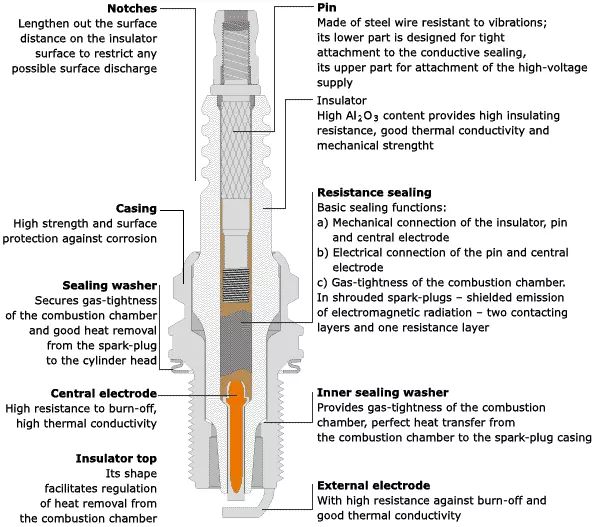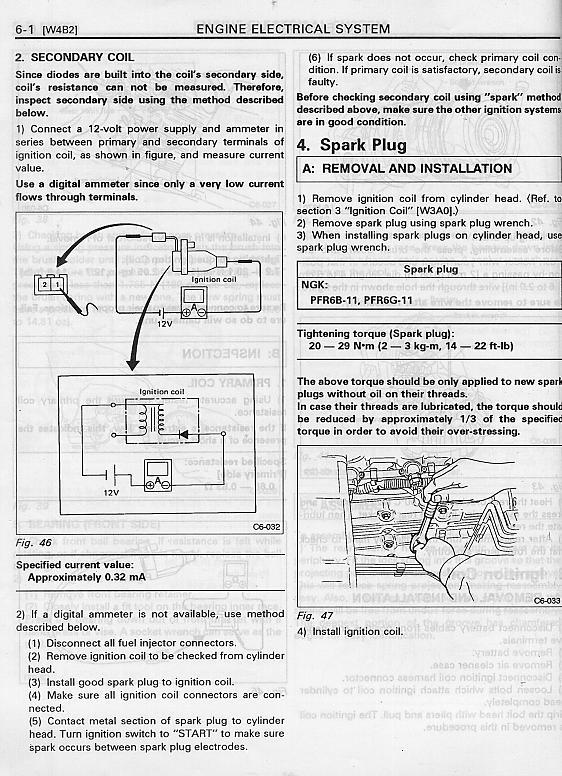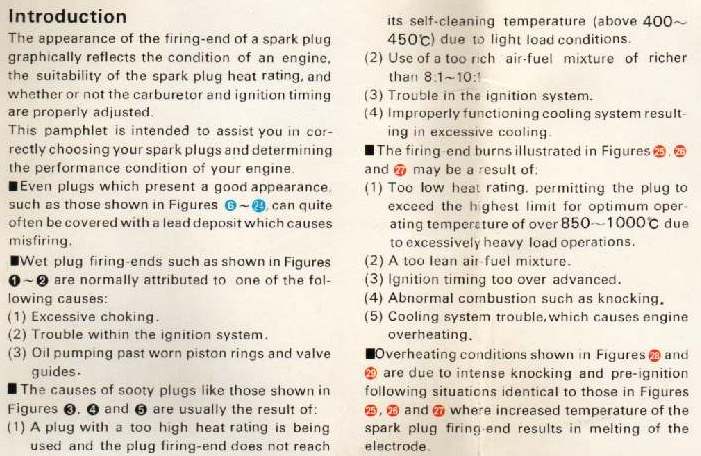If your ATV isn’t getting spark from the spark plugs at the engine, you’re basically dead in the water. This can be an extremely frustrating spot to be in because the engine won’t turn over and won’t give any hints as to why. I’ll tell you exactly how to check for spark on an ATV, and if you’re not getting any, how to diagnose the electrical components to find out exactly where your problem is.
To quickly tell if your ATV is getting spark, remove the spark plug from the engine. Reinsert the plug back into the coil wire. Hold the electrodes of the spark plug close to the engine to ground it, and try starting the engine. If you see spark coming from the end of the spark plug, your ATV engine is getting spark.
Keep in mind, on some models you will need to have the handle bar switch in the run position and the rear brake applied. Look for any other red buttons or kill switches that might have been pressed. A lot of quads have fail safes you need to think about when trying to start the engine.
If you have a hard time being able to tell if you can see a spark or not, you could always have a buddy hold the electrodes of the spark plug. If he yells when you try to start the engine, you have spark.
There are a few reasons an ATV won’t be getting spark from the spark plugs. The electrical systems on these quads can get a little tricky sometimes. Your best bet is to just check one thing at a time making your way down the list until you’ve found your problem.
The most common reason an ATV is getting no spark is a bad spark plug, either the wrong plug all together or just not gapped correctly. Or the spark plug just went bad, that happens quite often and it’s normal.
If you find out you need to replace the spark plug, you can usually find them easily on Amazon here: ATV Spark Plug.
If you know your spark plug is good and gapped correctly, then you’ll want to check for a loose wire, a bad switch, a bad connection, the ignition coil, or a problem with the stator. Lets go over how to check these one by one.
Lets go over how to check these one by one.
First, you’re gonna want to check the condition of the spark plug wire or ignition coil wire. This is the wire that hooks up to the spark plug when it is bolted into the engine. Sometimes these wear out because the wire itself is usually exposed to dirt, rocks, and debris while riding.
If the spark plug wire looks good, the next step is to check for bad connections or bad switches. To do this, disconnect the main electrical connector coming out of the engine. Doing this will unhook the kill switch, ignition switch, and all the wiring associated with those switches. Check to see if you get spark now.
If you got spark after unhooking the main electrical connector, then your problem is one of those switches or the wiring for one of those switches. Now your task is to go through and disconnect each switch one at a time to find the problem part. It will help to have an ohm meter to check each switch and each wire separately.
First off, you’re going to need a digital multi-meter to test the electrical components of your ATV. If you don’t know what that is, check out this Fluke 115 Compact True-RMS Digital Multimeter on Amazon. That’s the one I have and use, and I recommend it if you’re in the market for one.
You will also need basic tools to get the ignition coil on and off the machine. If you want to be extra safe, you could unplug the battery before starting. But I find it’s ok to just unplug the wiring to the ignition coil before removing it.
To locate the ignition coil, simply follow the wire connecting to your spark plug. Once you have the ignition coil out, you can hook your multi-meter up to it to begin testing. Start by testing the primary side of the ignition coil, where the ignition coil was wired, not the side that goes to the spark plug.
You should see between 0.2 and 5 ohms of resistance. That is a wide range because it varies from machine to machine. It’s best to look through your service manual to see what your ignition coil should read on its primary.
It’s best to look through your service manual to see what your ignition coil should read on its primary.
Next lets test the secondary side of the ignition coil. This is the side with the spark plug caps. If your ignition coil has two spark plug caps, simply put the red test lead in one and the black in the other. Look for around 16k ohms resistance, but again you should check your service manual for your specific measurements.
If you only have one spark plug cap, you will take one multi-meter lead and connect to the spark plug cap and the other to the primary side power connector.
Use the spark plug cap as if it’s the negative side of the primary for this test with that type of ignition coil.
Again you will need a multi-meter and basic hand tools to remove the stator. You either have a single phase or a three phase stator. Three phase is the most common, and probably the type you have.
To make sure, check the wiring harness coming from your stator, If you see group of three wires of the same color (usually white, yellow, or black) you have a three phase stator. A single phase stator will not have that set of three wires.
A single phase stator will not have that set of three wires.
To start with the three phase stator, set your multi-meter up for ohms. Now get the connector with those three same colored wires we talked about before. You are going to be testing each of those wires against each other. So leg one vs leg two, leg two vs leg three, and leg three vs leg one.
You can do this by simply inserting the multi-meter leads into the connector. You should typically see between 0.1 – 1 ohms for each measurement. But check your service manual for your specs on your machine.
If your meter reads OL, that stands for open line, and you will need a new stator. To check if your stator is shorting to ground, simply hook one lead to a stator leg (through the connector) and the other to the stator body or chassis ground on your machine. You should not get any reading on your meter. If you do get a reading on any of the legs, you will need to replace your stator.
You can do this testing while the stator is still on the machine if you’re able to access it. I find it easier to remove the stator to do the actual testing, but that can be a pain all on its own.
I find it easier to remove the stator to do the actual testing, but that can be a pain all on its own.
That’s it for the most common electrical problems you’ll see with your ATV. It’s usually something like a bad kill switch or loose wire or connection. Hopefully you find your issue with out too much trouble.
Electrical problems can be some of the most time consuming. If you have the money to spare, it may be worth it to just bring your machine to a shop if you don’t feel like messing around with all the potential causes.
Even then, it doesn’t hurt to quickly look over some connections before calling in a professional.
Sharing is caring!
I’ve been riding ATVs for quite a while and a question people who haven’t changed their spark plugs before or have a new ATV often need to know is when should you change your ATV spark plugs. I looked at the owner’s manuals for the most popular brands and thought I’d share when you should do it.
I looked at the owner’s manuals for the most popular brands and thought I’d share when you should do it.
On average, every 6 months, 600 miles (1000 km), or 100 hours, whichever comes first according to the owner’s manual of popular ATVs such as Polaris, and Honda. A good rule of thumb is to inspect them every 6 months and change them as necessary.
Certain ATV models such as the Yamaha Kodiak say to check them after the first 1 month, and 3 months. So, there can be some variation depending on the make and model of the ATV. Today, I’ll explain the general procedure for inspecting and changing the spark plugs. As well as, what happens when an ATV spark plug is bad.
Components in ATV engines wear out, and I’ve found routine maintenance every 6 months is about right. But, how long do ATV spark plugs last specifically?
Overall, ATV spark plugs last 6 months or 600 miles (1000 km), whichever comes first. They can last longer or shorter depending on how aggressively an ATV is ridden. If you regularly rev the engine to very high RPMs and put a lot of torque on the ATV it can shorten their life.
They can last longer or shorter depending on how aggressively an ATV is ridden. If you regularly rev the engine to very high RPMs and put a lot of torque on the ATV it can shorten their life.
The same is also true if you ride your ATV very gently. But, on average every 6 months for most ATVs is about right. A spark plug is a mechanical component that has parts made of metal. Over time they can wear out, become corroded, or become very dirty.
Spark plugs are fairly inexpensive and very easy to change. Here’s a table that shows when top ATV brands recommended changing the sparkplugs:
| ATV Model | When to Inspect/Change |
|---|---|
| 2020 Honda – Rancher | 600 miles (1000 kms), 6 months, or 100 hours. |
| 2020 Polaris – Sportsman 450 | 600 miles (1000 kms), 6 months, or 100 hours. |
| 2020 Yamaha Kodiak 700 | 600 miles (1000 kms), 6 months, or 100 hours. |
The 2020 Yamaha Kodiak 700 is a bit different because in the user manual it says to check the spark plugs after the first month when you get it and after the first 3 months. Then periodically every 6 months similar to the other popular ATV brands.
Then periodically every 6 months similar to the other popular ATV brands.
This also shows that the exact time requirements for when spark plugs will wear out, and when to change them differs by make and model. In the first instance, you should always refer to your owner’s manual to see exactly when you should change/inspect them.
The owner’s manuals will also state what size, and what type of spark plug to use as a replacement.
For each timeframe, they also give mileage and the time it has been operating in hours. The reason is that if you ride your ATV a lot then it will create more wear and tear on the spark plugs. And you should check them sooner. Certain ATVs have both an odometer and a meter that displays how many hours it has been used.
But, the engine can be idle and still running without putting on any miles or kilometers so the operating hours are also used as a gauge of wear and tear.
Now that you’re aware of when to change your ATV spark plugs, how do you know if they’re worn, and whether they need replacing.
An oil change, which includes changing the oil filter, needs to be done periodically. Many people wonder how often you need to change the oil and the oil filter on their ATV.
I explained this in another article by looking at how often it needs to be done for the most popular ATV brands to answer this question. As well as explain what’s involved in this article here about how often you need to change the oil on ATV.
Although the owner’s manual of popular ATVs recommends inspecting the spark plug and replacing it every 6 months, you may be wondering how to know if a spark plug on your ATV is bad. Here’s how to know:
Signs that your spark plug is bad are if your ATV is harder to start, the acceleration isn’t as good as it normally is, it’s consuming more fuel than normal, if the engine backfires, or if you notice it isn’t idling smoothly once warmed up.
These signs can be indicative of other issues. But, generally, they are clear signs there is an issue with one or more of your spark plugs. The spark plugs themselves can also be checked individually to see if they spark. Here’s a quick video that shows how it’s done.
But, generally, they are clear signs there is an issue with one or more of your spark plugs. The spark plugs themselves can also be checked individually to see if they spark. Here’s a quick video that shows how it’s done.
It’s fairly easy to check if you’re getting a spark from a spark plug using the test above. But, what are the effects of a bad spark plug? And what does it do to a four-wheeler/ATV?
A bad spark plug will cause the engine to misfire, backfire, use more fuel, and not accelerate with the same power it normally does. The spark plug is responsible for igniting the fuel which turns the pistons. When it’s not creating a spark the fuel won’t ignite efficiently or smoothly.
A spark plug works by drawing electricity from the battery to create the spark which lights the fuel. If the spark plug is not working correctly it won’t spark consistently.
This can lead to fuel not being burned completely, which means the engine needs to use more oil. If you’re idling your ATV, and the engine is fully warmed up, the engine should run constantly and smoothly.
If you’re idling your ATV, and the engine is fully warmed up, the engine should run constantly and smoothly.
If the spark plugs are misfiring then the engine won’t vibrate consistently and you’ll notice it sputters. Due to some of the fuel not being used, there can be a build-up that will cause a loud backfire.
At first glance it seems that ATV spark plugs are small parts. But they are responsible for igniting the fuel mixture and starting the ATV. In addition, the candle is a kind of "indicator" of the health of the equipment, and can inform the rider about a number of malfunctions. Therefore, it is important for the driver to know when, after buying an ATV, to change this component and how to do it correctly.
The spark plug is basically a consumable item. The technical documentation for the device indicates the manufacturer's recommendations when to change this component. On average, the "life" of a candle is 6-8 thousand km. However, it all depends on the condition of the ignition element. The following can reduce the life of a component:
On average, the "life" of a candle is 6-8 thousand km. However, it all depends on the condition of the ignition element. The following can reduce the life of a component:
Damage to the element will cause a number of problems. For example, if the rider noticed that there was no spark on the ATV spark plug, it became difficult to start the engine, fuel consumption increased, or the engine started to work incorrectly, you need to change the spark plug.
It should be noted right away that the resource and operation of a spark plug directly depends on its quality. Therefore, drivers should only buy proven products from well-known brands. Agree, it is easier to buy a good component that will last 8 thousand km than to buy a new part every 1.5-2 thousand km.
There are also a number of parameters to consider when choosing a new component for the ignition system. The key role is played by the dimensions of the candle itself (thread diameter and its length). You need to pay attention to the heat number. This is also an important parameter, ignoring which can lead to uncontrolled ignition of the fuel mixture upon contact with soot or hot engine elements.
To avoid problems, a special marking is applied to the plug, which indicates the permissible temperature of the component and its resistance to pre-ignition. This is a really important characteristic, because the piston is destroyed due to uncontrolled ignition.
Low spark plug temperature will also damage your ATV. If you buy a component with too high a heat number, carbon formation will increase and the engine will lose power.
Most often, on the market you can find candles with glow number:
Before you buy a spark plug for a children's ATV or an adult ATV, always study the technical documentation. The instructions usually indicate the optimal parameters of all consumable components.
It is important to note that in order to change the spark plug, you will have to remove part of the ATV's bodywork. In almost all quadrics, the component is covered with plastic parts and even accessories (gas tank, etc.).
In almost all quadrics, the component is covered with plastic parts and even accessories (gas tank, etc.).
After you have dismantled the body part, you need:
After this, inspect and clean the spark plug (if you intend to continue using it). Inspection of the component should not be ignored, as it will help to detect problems in the operation of the ATV.
By the type of spark plugs on the ATV, you can determine the serviceability of the equipment. For example, if:

And these are only the most common "diseases" that can be diagnosed with a spark plug.
02/19/2021 1864
From cars and lawn mowers to ATVs and motorboats, internal combustion engines can be found in virtually all vehicles that use spark plugs to provide the ignition process. On the one hand, these little “wonder helpers” consume high-voltage electricity, and on the other hand, they give out a spark. The spark ignites the fuel mixture in the engine, thereby providing the combustion process that keeps the engine running. Without the spark plugs, the engine would be unable to start, so spark plug failures can cause the engine to stop completely.
List of possible symptoms of bad spark plugs:
Damaged or dirty spark plugs can cause a variety of problems including increased fuel consumption, slow acceleration, misfiring and starting problems. If you're having problems with your engine, the first thing you should look at is the spark plugs - this is a good place to start figuring out what's causing it.
By examining the condition of your engine's spark plugs, you can get an idea of how well your engine is performing. You can make this check part of the regular maintenance of your car, ATV, lawn mower, or motorcycle, or you can do it whenever you suspect something is wrong with the engine.
The first step is to remove the spark plug that needs to be examined. Take the spark plug and inspect it for signs of damage. Pay special attention to the end of the candle that was screwed into the cylinder and examine it. It is highly likely that you will notice one of the following signs on it.
During normal operation of the spark plug, brown or grayish-brown deposits can be found on its ground electrode. If they are, then everything is in order with the spark plug, it can be installed back into the cylinder.
Black dry soot on the electrodes and tip of the insulator indicates carbon contamination. This can be caused by a dirty air filter, driving too long at low speeds, too rich an air/fuel mixture, or idling too long. A car mechanic can advise on what type of spark plugs to purchase to replace a damaged one, but you may want to consider switching to a "hotter" spark plug (the lower the glow number of the spark plug, the higher its temperature).
Black oil deposits on the electrodes and the tip of the insulators indicate contamination of the spark plug with engine oil. Oil can leak into the cylinders due to worn pistons or valve guides. It is very important to locate the source of the leak, consult a mechanic for more detailed instructions. Once the cause of the faulty spark plugs has been resolved, the spark plug can be changed.
The photo clearly shows oil deposits on spark plugsA wet spark plug can be the result of something called "flooding" of the engine. This situation occurs when you repeatedly try to start the engine several times, but without igniting the fuel mixture. In this situation, you can clean the spark plugs or just wait until they dry themselves.
Dross on the tip of the insulator, melted electrodes or white deposits are signs of a burnt spark plug that is exposed to too high temperatures during operation.